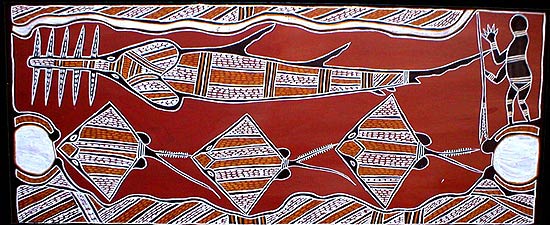| Like people, stingrays carry spears, but only use them in self defence. According to Yolngu belief, Gawangalkmirri is a devoted parent, carefully preparing a safe home in which to give birth, called Yirrnga. In this home, like human parents, Gawangalkmirri teaches its children everything they need to know to survive. This behavior is a metaphor for the passing of sacred lore from the elders to the new generation. As a result, Gawangalkmirri has come to represent cultural survival for the Gumatj clan.

The ancestral sawfish carves-out the Angurugu River on Groote Eylandt followed by three creator stingrays.
An ancestral hunter watches from the riverbank, waiting to spear some rays for a feast.
Culture: Anindilyakwa, Clan: Maminyamanja, Artist: Nekingaba Maminyamanja, Date: c. 1980.
Collection of Matthew McDavitt.
This remarkable stingray holds other symbolism. During ancestral times, Gawangalkmirri fought with the crocodile ancestor Baru after he killed a stingray clansman. Instead of killing the crocodile for this outrage, Gawangalkmirri avenged the murder by spearing Baru in the thigh. This act of restraint became the model for the Yolngu peacemaking ceremony called makarrata.
In addition, Gawangalkmirri is associated with the fertility of the landscape. Mangrove stingrays give birth among the mangrove prop-roots at the beginning of the wet season. As they nuzzle into the seafloor to make their birthing pit, their digging is said to activate sacred ancestral power-wells, triggering the development of wet season clouds. There is seemingly a connection between the clouds of silt stirred-up by nesting stingrays and the development of thunderheads. Because the wet season brings renewal of life throughout the tropical north, these stingrays are linked to the fecundity of the landscape itself. As is evident from this brief description, this ancestral ray symbolizes many positive attributes including social harmony, good parenting, cultural survival, peacemaking, and the fruitful earth.
Final thoughts
As is clear from these examples, indigenous peoples view elasmobranchs in a balanced way, finding them worthy of respect and admiration. Instead of fearing the predatory prowess of these fascinating fishes, Aboriginal people see in them strength and values which are a model for human behavior. Very few sharks and rays ever pose a threat to mankind, and now our activities threaten the survival of species such as the freshwater sawfish and the grey nurse shark. If we can change our attitudes about these misunderstood animals, perhaps we can save them before it is too late.
Jacqueline Foster ( MESA) adapted this information sheet (which is suitable for primary school students) from the information sheet compiled for the general public by © Matthew T. McDavitt (MTMcDavitt@aol.com).
This information sheet may be copied for educational purposes. For any other purpose please contact your State MESA representative: http://www.mesa.edu.au/council/contacts.asp |
